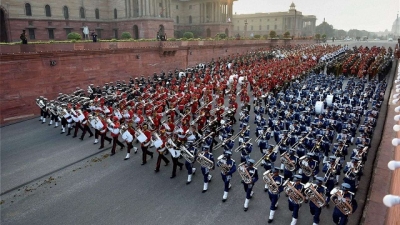
Martial music tunes and patriotic renditions marked this year’s Beating the Retreat ceremony recently held in Delhi. But what is the Beating the Retreat ceremony all about? When is it performed? What is its significance?
When is it performed?
The Beating the Retreat ceremony is performed on January 29 every year at Vijay Chowk in New Delhi, against the backdrop of the majestic Rashtrapati Bhavan, the official residence of the President of India. It marks the culmination of the week-long Republic Day celebrations which this year began on January 23, the birth anniversary of Netaji Subhas Chandra Bose. You all are probably aware that Republic Day is celebrated on January 26 every year to commemorate the adoption of the Indian Constitution in 1950, when a grand parade is held in the national capital New Delhi.
Coming back to the ceremony, it gets its name from a centuries-old tradition of troops withdrawing from the battlefield at buglers sounding the retreat at sunset. As soon as the retreat was sounded, the troops ceased fighting, sheathed their arms and withdrew from the battlefield. The military tradition began in 17th Century England, when King James II ordered his troops to beat drums, lower flags, and organise a parade to announce the end of a day of combat. The Beating the Retreat ceremony in India traces its origins to the early 1950s when Major Roberts of the Indian Army indigenously developed the unique ceremony of display by the armed forces and their bands comprising drums, pipes, and trumpets. The Beating Retreat ceremony is still being performed by the armed forces in the U.K., the US, Canada and India among others.
The President of India, who is the Commander-in-Chief of the Armed Forces, is the chief guest at the ceremony and he is escorted by the President’s Bodyguard, a mounted regiment of the Indian Army. Bands of the Army, Navy, Air Force, and Central Armed Police Forces together perform various drill movements and form beautiful patterns. As soon as the bugle sounds the retreat, all flags are lowered, the marching bands move away, and the whole Vijay Chowk square lights up in a spectacular display.
What was new this year?
This year, the ceremony included for the first time in India’s history a laser show and drone formations. The ceremony was conducted on a grand scale to celebrate the country’s 75th year of Independence in 2022. As the sky turned dark, the laser show projected on the walls of the North and South Blocks at Raisina Hill traced the history of the country’s freedom struggle, and its journey post independence, accompanied by I narration. The drone show, comprising 1,000 made-in-India drones, was captivating from the word go and the formations on the sky included the globe, the map of India, Mahatma Gandhi’s image and the “75 Azadi Ka Amrit Mahotsav” alongside the tricolour with synchronised music playing in the background. The 10-minute drone show was put together by a startup Botlab Dynamics with the support of IIT Delhi.
As many as 26 tunes, including “Amar Chattan”, “Hind Ki Sena”, and “Sare Jahan se Achcha” were played at the ceremony. However, the song “Abide With Me” which had been part of the ceremony since 1950, was dropped this year. According to reports, the Government felt playing more Indian tunes would be appropriate with the country celebrating 75th year of its Independence this year. The hymn was replaced with Kavi Pradeep’s “Aye Mere Watan Ke Logon”, which was written to commemorate the Indian soldiers who sacrificed their lives for the country during the India-China war of 1962.
Picture Credit : Google




